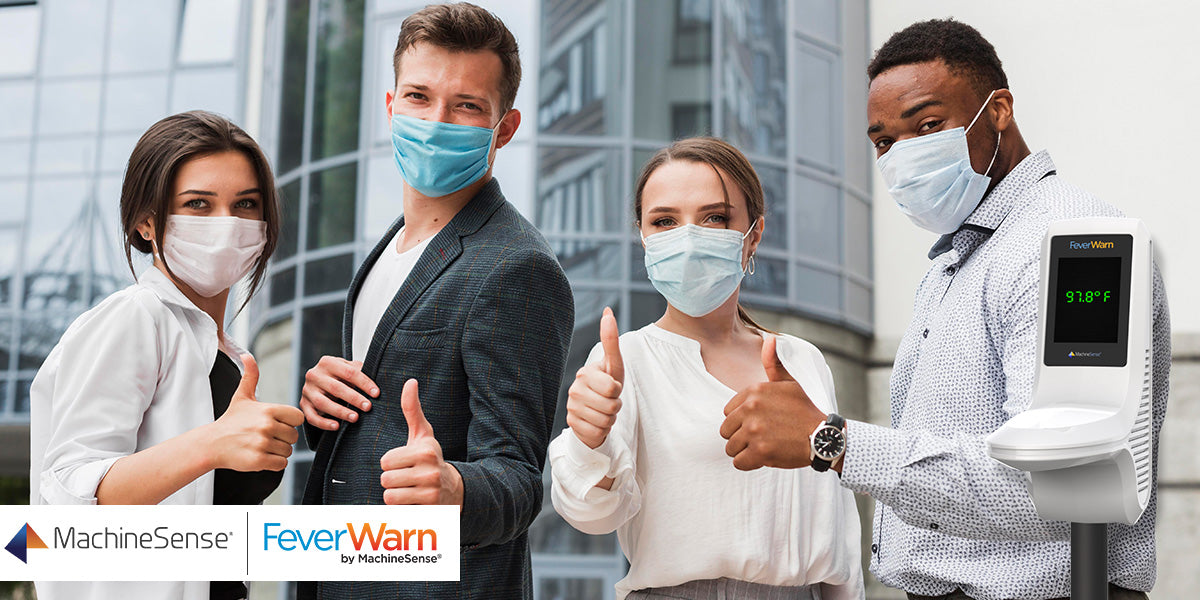

How Businesses Can Ensure Accurate & Efficient Readings for Taking Employee Temperatures
Last year, the New England Journal of Medicine published a physician study on the clinical characteristics of over 1,000 Chinese patients who had laboratory-confirmed Covid-19.
Controlling for age, secondary health conditions, geographies and other patient factors, the most common COVID symptoms were fever and a cough.
Equally, in its continuously updated clinical guidelines for the detection and treatment of COVID-19, the U.S. Center for Disease Control (CDC) lists fever among its most common presenting or post-hospitalization symptoms.
So what do we mean by ‘fever?’ The average normal body temperature is generally accepted as 98.6°F, though some studies have shown that a "normal" baseline can range from 97°F to 99°F. Most of the time, anything over 100.4°F (38°C) means fever, and fever may signal COVID, influenza or another illness.
Therefore, as schools, workplaces, businesses, airports and other public-access buildings work to prevent infection spread, many are temperature screening their employees and the public as a reliable marker for potential COVID-19.
Getting it Right: How Can Your Organization Ensure Accurate Temperature Readings?
Earlier this spring, during a Facebook Live event, Dr. Anthony Fauci, director of the National Institute of Allergy and Infectious Diseases and advisor to the White House, told a story about one, recent workday. On that hot-weather day, Dr. Fauci underwent three workplace temperature screens, and each screen yielded a different reading: 103°F (at the White House); 97.4° F (in an air-conditioned car) and 93° F (at another facility).
From location to location, that’s a 10-point variant. That’s one workday.
“The temperatures are notoriously inaccurate, many times,” Fauci said.
So why, during our doctor-office checkups, do clinicians take our temperature and log it into that visit’s clinical notes?
That thermometer in our mouth or ear or under our tongue? It reads our core body temperature—as in, our body’s internal organs such as the heart, liver, brain or blood.
By contrast, non-contact temperature screeners such as IR forehead guns or thermal cameras—now used to screen the public in many public spaces—only read our skin or surface temperature. If a reading indicates fever, this thermal imaging read may then be followed up with a second screening to determine whether that person must be refused entry, quarantined or other designated COVID-control procedure.
As Dr. Fauci explained, surface temperature-based reads fluctuate based on many factors, including location, the weather, recent exercise, the time of day and the room or outdoor temperature. In fact, in our facial area alone, our foreheads can be hotter or colder than our cheeks by four degrees. Also, based on air temperature, an air-conditioned room may yield a different result from a testing tent in your workplace parking lot.
Therefore, when it comes to checking for the presence or absence of viral load or potential disease, traditional, non-contact screeners can yield a false negative or false positive. Also, many traditional infrared, non-contact thermometers can only operate when the surrounding temperature is at or above 70° and below or at 90° degrees.
Balancing Temperature Scanning Accuracy with Privacy, Social Distancing and Organizational Risks
So if our doctors’ offices can get it so right, why can’t all organizations use old-fashioned mouth or ear thermometers?
They could. Except for a few issues—some of which are logistical and some of which are regulatory or legal.
When schools, workplaces or other public-access organizations institute temperature screens, they must also comply with the CDC’s social-distancing mandates and OSHA’s safe-workplace practices, including protecting the appointed and trained scanner from potential exposure.
Add to these the issue of whether a mouth or ear thermometer represents a medical procedure which, in turn, presents potential legal issues and risks for employers and public organizations, including the risk of violating individual privacy.
Then there’s the challenge of frequently and efficiently scanning and collecting HIPAA-protected temperature data on hundreds or thousands of people—often within a defined timeline--say, at the start of a school day or a specific work shift.
Accurate, Efficient and Affordable: How to Get Accurate Core Body Temperatures Scans
Based on a certified laboratory study, we know that the FeverWarn®’s non-contact, high-accuracy and FDA-compliant human thermometers yield a core-body temperature reading that is very close (within the 0.5 range) to a clinical (ear, mouth, armpit) reading.
Temperature accuracy and efficiency (our self-serve system can measure someone’s temperature in as little as 1.5 seconds), make FeverWarn the system of choice for our healthcare, educational, corporate and other customer organizations who are accurately and quickly screening large volumes of their visitors, students and visitors. Our customers also enjoy the ease and reliability of FeverWarn’s highly secure data handling and reporting dashboards.
Finally, FeverWarn systems start at $599, a fraction of the price of camera-based thermal scanners, and significantly less than paying an employee to provide health screens with a handheld thermometer. FeverWarn also works with municipal procurement systems and is NDAA compliant and a GSA-approved vendor.
So why use costly systems that only measure surface temperature and that can yield inaccurate, surface temperature screens?
Watch our explainer videos or contact us to find out how our unique, multi-step bio virus prevention system can help to safeguard your organization’s immediate and long-term (think COVID variants and wintertime influenza season) disease-prevention initiatives. https://machinesense.com/pages/feverwarn.

